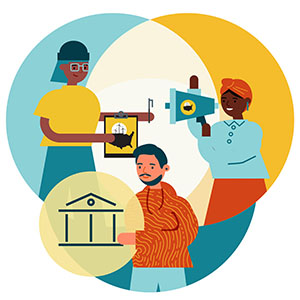The Role of Online Organizing

Online organizing is part of campaign organizing, your communication strategy and delivery, and your policy work.
Online Organizing is Part of Campaign Organizing
Online organizing activates and engages people, builds relationships, develops leaders, and ultimately grows our grassroots power. It is key to winning our immediate campaign goals and supporting the movement for the long haul. Talking to people one-on-one or engaging with our allies and supporters in-person at meetings, rallies, or events is crucial for campaign organizing — but importantly, online organizing brings even more ways to connect by focusing on building relationships and support online. Email, mobile, social media, and the web are all places where we can reach a wide audience and ask them to click, attend, sign, donate or share all sorts of actions — without anyone leaving their homes. This can make a huge difference for busy people who want to help, but can’t always find the time it takes to join our teams in-person.
Online Organizing is Part of Communications
Online organizing, like many communications tactics, is working to reach massive amounts of people with relevant and timely content. But instead of writing a letter to the editor or getting air time on your local radio station — actions with the goal of educating and persuading the reader, listener, or watcher — online organizing is about engaging your audience by giving them easy, accessible, and meaningful actions they can take right away.
Online Organizing is Part of Advocacy Work
Online organizing is involved in advocacy and can be used for both administrative advocacy or legislative lobbying. Some online organizing activities that are administrative advocacy might involve asking activists to sign a petition or make phone calls, asking followers to tweet at a decision maker, or coordinating attendance at an event. Requesting specific action on a bill or using online tools to influence a target’s decision on a piece of legislation constitute legislative lobbying.
Online Organizing Always Has a Call to Action
The main difference that online tactics have from other aspects of your campaign is that they should always incorporate a call to action (or CTA). Every email, Facebook post, or text you send should include a way for your audience to take an action — such as visit a website, sign a petition, or share a social post.
Thankfully, Sierra Club already has lots of valuable tools you can access to help reach your audience, manage online campaigns, and get people to take action. Explore the rest of this guide to learn about when and how to use each of these tools to incorporate online organizing into your campaign.
An Introduction with Digital 101
Explore which tools are in your digital toolbox and how to use them, and then get started with digital strategy and planning.
Get Started